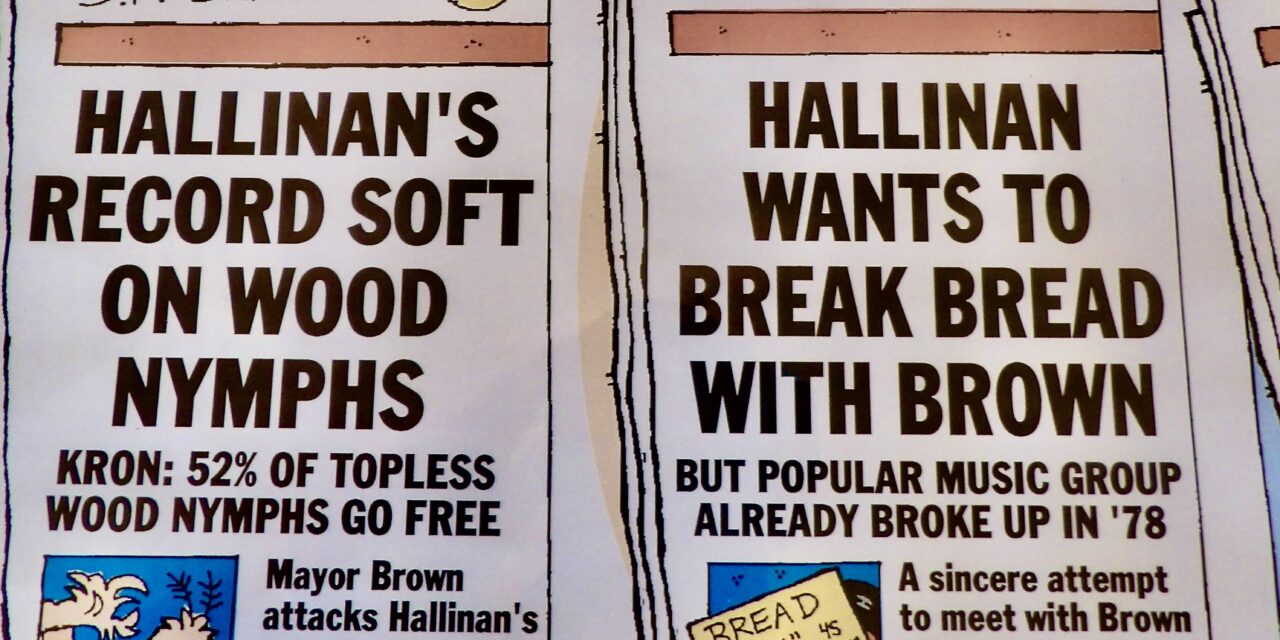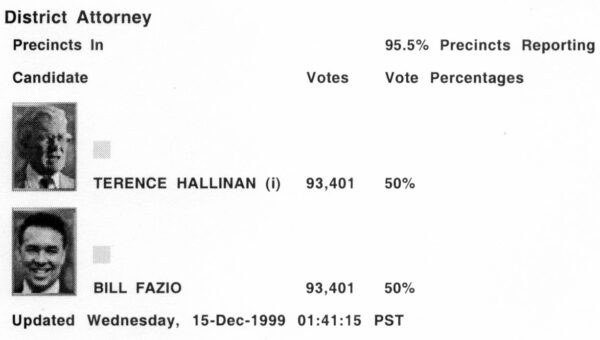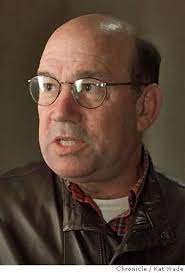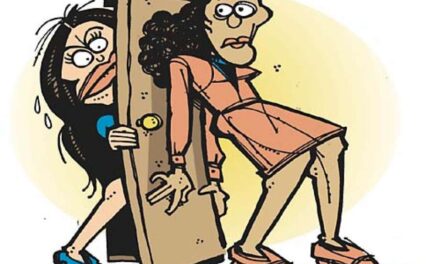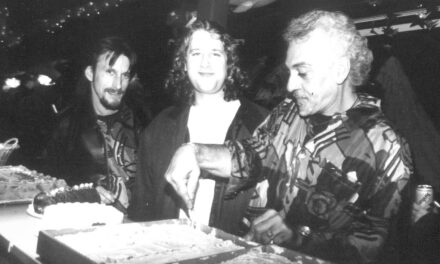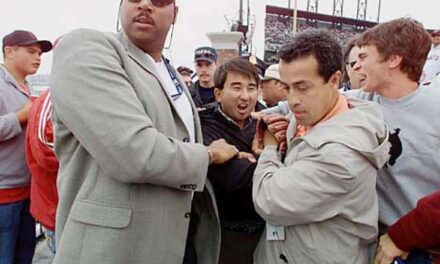Senator Dianne Feinstein had told Terence Hallinan bluntly after he was elected district attorney in November ’95 that “we” would not let it happen again. He assumed that DiFi’s “we” meant the power elite of San Francisco and/or the Democratic Party. Running for re-election four years later Hallinan was opposed by Bill Fazio (whom he’d edged out in ’95 and then fired along with 13 other assistant DAs soon after he took office) and Deputy Public Defender Matt Gonzalez, who contended that “America’s most progressive district attorney” had been charging cases —including marijuana cases— too harshly. SFDA investigator Ross Mirkarimi, who had managed Hallinan’s campaign in ’95, took a leave of absence to reprise his role (after Kamala Harris, concerned about her boss’s prospects, had urged him to do so). He and Gonzalez were Green Party allies —they had both campaigned for Ralph Nader in ’96— but Mirkarimi’s primary loyalty was to Terence.
Labor Day is said to be opening day of the campaign season and on September 4, 1999, the Hearst-owned San Francisco Chronicle kicked it off with a massive front-page hit piece focused on Hallinan’s conviction rate, the lowest in the state. Evaluating a prosecutor’s proficiency by measuring their won-loss record ignores the category of saves. Statistically, a DA’s conviction rate turns each save into a loss —an arrest that didn’t result in a conviction. But from Hallinan’s POV, saves were wins, “alternatives to incarceration.” To give an example from my first week in the office, Swords Into Plowshares had brought to Hallinan’s attention the case of an Air Force veteran who was facing 25-to-life for, essentially, being a drug addict with emotional problems. Hallinan allowed him to enter a residential treatment program —which counted as a loss for the DA’s office. Such cases don’t make the media, nor should they (people in recovery don’t need publicity); but they skew the statistics.
In November Matt Gonzalez had finished third with a respectable 11%. In the December run-off Fazio led in the early returns. As reporters and journalists hovered in the basement of city hall, the elections commission issued periodic updates. At 1:41 a.m. Wednesday morning the race was exactly even. By morning Kayo had 50.4% of the vote and was declared the winner.
By lunchtime San Francisco politicos were abuzz with talk of a recount or, if that failed, a recall. A friend called Kayo to say that Fazio (who he liked, personally) was discussing his eventual assumption of the office as though it was a done deal. Kayo’s incoming chief assistant, Darrell Salomon, advised him to shore up his right flank by hiring Kimberly Guilfoyle as an assistant DA to please the “the Irish Cultural Center crowd and the Gettys.” Guilfoyle had been hired four years earlier by Kayo’s predecessor, Arlo Smith, as he was leaving office; Kayo had literally disappointed her back then. In 2000 he welcomed her, but the attacks from the corporate media did not abate. My job as his press secretary was to fend them off. “Always stay on your toes,” was his oft-repeated advice.
The basic line of attack, echoed by Mayor Willie Brown, was to blame Hallinan for every manifestation of social breakdown in San Francisco. The campaign would culminate in September with an extraordinary meeting of all city department heads at which grounds for a recall election would be considered. Kayo sensed that Brown was planning a humiliating ambush and sent me and Paul Cummins in his stead. We sat around a magnificent oak table in the mayor’s spacious conference room —the chiefs of the Police and Fire Departments, Emergency Services, the Port, the Public Defender, MUNI, Public Works, Public Health, the airport… even the Public Library and the Zoo. The mayor was late and his aide, Bevin Dufty went to find him.
Dufty returned with word that the mayor was still on the phone with “an important Chinese trade official.” A few minutes later Willie Brown walked in smiling from ear to ear and said almost reverently, “I just got off the phone with Jiang Zemin’s son!” Jiang Zemin was the president of China. the mayor of San Francisco continued to look blissed out. I suddenly understood the extent to which China is where it’s at for the corporados whose interests Willie Brown was faithfully serving. Kayo told me later that Feinstein’s husband, Dick Blum, handled $7 billion worth of US investors’ money in China.
The meeting began with a screening of a “news feature” produced by the Chronicle’s TV station, KRON, that aimed to expose SFDA’s inadequate prosecution of welfare fraud and drug cases. To the 20 or so politicians gathered around his magnificent oak table, the mayor mused about “statutory remedies” to Hallinan’s alleged leniency, and about asking the state attorney general (Bill Lockyer) to prosecute drug cases in San Francisco. The mayor started going around the table asking for input. Cummins and I were dismayed to hear Public Defender Jeff Brown tsk-taking about our boss. I forget who spoke next. He was sitting to Jeff Brown’s right and he, to0, decried the drug addicts around 6th Street. (I recently asked Dufty, who said that no minutes of the meeting were kept).
When a third department head started in –they were going around in a circle!– I decided to cut in. What I said, as best I can recall: “You think you’re looking at drug addicts, and that’s part of the story. But you’re also looking at mental illness and alcoholism and extreme poverty and homelessness and AIDS and hepatitis C, and these are things the DA can’t cure by charging cases more harshly. The police can clear the streets, but the next step has to be triage on a mass scale. Public Health and other departments have to be involved in deciding who just needs housing and who just needs outpatient care and who can handle a job and who needs residential care with someone to remind them it’s time to take a shower… and who needs confinement behind bars.”
The vague prospect of their own departments having to get involved gave them pause, I could sense. But then I blew it by going on. I described the long-vacant Public Health hospital at the Presidio as “a sin” in a city where people were dying on the streets. That solid brick structure had been falsely deemed unsound in the event of an earthquake, I said, “as some of you may know.” Willie Brown has an expressive face and I could almost see him calculating the feasibility of moving the rabble to a building just off Lake Street on the edge of Presidio Heights. I had lost him –but the lynch-mob momentum had been broken.
When the meeting ended the mayor told Vic Lee of KRON that he sensed “a stirring movement” among the department heads to “do something about District Attorney Hallinan.”
Cummins and I went back to 850 Bryant and reported to the boss. Paul told Terence he’d been wise to stay away and avoid a face-to-face confrontation with the mayor, whose obvious aim was pin the homeless crisis on him. I said I’d blown a chance to really redirect the conversation. We discussed our response to Robbie Peele’s questions, which Kayo asked me to email from home rather than faxing from the office on SFDA letterhead. The mayor was aiming for his head and he was bobbing and weaving.
Note to Vic Lee
Robbie Peele’s piece slamming Hallinan for leniency on “foodstamp fraud” was intellectually dishonest in charging that we, the taxpayers, were being ripped off when in fact the taxpayers’ outlay is identical whether or not the poor drug addicts sell their foodstamps for 75 cents on the dollar and eat at St. Vincent’s. News flash! Drug addicts will sell their foodstamps to get drugs!… Earlier Peele did an intellectually dishonest piece slamming Hallinan for leniency on “welfare fraud,” using the W-L framework to assert that Los Angeles convicts 95% of the cheats and SF convicts only 5% —never mentioning that Hallinan intentionally promotes a diversion program (which requires full financial restitution to the state) rather than make these people felons just when they’ve re-entered the work force, cost them their public housing, etc.
And now San Francisco gets your series on the district attorney’s prosecution of drug cases You went to the trouble of getting his comments on seven specific cases, but you didn’t provide them to your viewers. For openers, you accused Hallinan of mishandling the prosecution of Keisha Garrett —but didn’t run his explanation of how and why this young, crack-addicted mom got out of custody four times in six months. Garrett was charged three of those times and either released on her own recognizance by the judge, or she made bail, which is her constitutional right. She is now doing a year in the county jail, where she participates in a support community for young mothers. She had no prior convictions —all of which Hallinan and Vernon Grigg told you and Robbie Peele.
The three police officers you interviewed stand to collect substantial overtime when cases are tried, because they get paid to stand by to testify. I think you were obligated to ask Martinovich, Laughlin and Miller how much they made last year in OT. When the DA offers diversion or accepts a misdemeanor plea instead of trying a case as a felony, these guys stand to lose money. Hallinan represents a threat to their more-than-$100,000-a-year incomes (1/3 of which might be OT).
All seven of the defendants whose “lenient treatment” you protested were black or latino, and all the narcs were white (and from Novato). The war on drugs is an excuse for the ruling class to keep the police well armed and at the ready and in control of the populace, particularly the poor. The police may have working-class cousins but they themselves are “privileged labor.” In addition to being well paid (relative to the rest of the working class), they are glorified in the culture from morning till night. Their obvious role is to maintain the rich/poor system, which they take to be in their interests. Seventy-five percent of the arrests they make are for violations of the drug laws, and another 10-15% are robberies and burglaries to support drug habits. If we ended the illicit drug trade by ending the prohibition, think of the resources that could be put into making the city secure and livable.
The narcotics officers who have it in for Hallinan frequently repeat a line about individual dealers getting “back out in no time” as a result of the DA’s “leniency.” You failed to inform your viewers that after people get taken to jail in San Francisco, releasing them is the sheriff’s call. Sometimes they’re back out before the case is even presented to the DA for charging. As you know —but never reminded your viewers— jail overcrowding resulted in a federal judge overseeing the SF jails, and levying daily fines on the county for exceeding capacity.
The police make so many drug arrests in San Francisco —“more than any other Bay Area county,” as you put it— because San Francisco is where people come for the conventions, theaters, clubs, hotels, etc., i.e. where the customers are likely to be. And unlike other counties, the police bring all their arrests to the DA for charging, whether or not a case is obviously flawed.
Cops on the beat would solve the problem outside the grocery. How come you never see cops walking the beat in San Francisco? Also, half the strung-out people on the street outside were strung out on alcohol. Alcohol and poverty unto homelessness —not just drugs— create the Tenderloin street scene.

